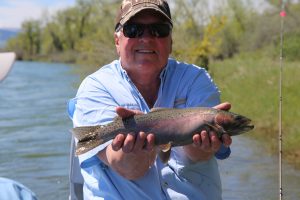Archive for August 2017
The Bighorn River (Part 1)

Dave Tronnes with a dark, fat Bighorn River rainbow in May, 2017.
We have grown this year as a company. High N Dry Fishing Products decided to improve our social media and web presence. We know we can provide information and entertainment to our customers and end-users is through our blog page. Thus – you are seeing the very first High N Dry blog. This is the first time I’ve ever actually written a blog post, so be patient with me as I learn what the heck I’m doing. I hope this blog will be a pleasant mix of information and entertainment. It will cover many areas related to fly fishing in general, but information related to our products as well.
This post is the first of three on a subject near and dear to my heart – the Bighorn River. The Bighorn River is the first “real” river I fished when I was learning how to cast a fly rod. It is also the first river I floated without a guide.
The High N Dry crew recently met in Ft. Smith, Montana for a quarterly business meeting and, of course, to fish. Ft. Smith is a small, rural community in southeast Montana. Although in existence since the mid 1800’s, it was rejuvenated as a hub of outdoor recreation due to its proximity to the Yellowtail Dam, the Bighorn Canyon National Recreation Area, and the Bighorn River. Since this blog is intended for our website, I have to mention that you should stop in to the Bighorn Angler, the Bighorn Trout Shop, the Bighorn River Lodge, or the Bighorn Fly & Tackle when you are in the area. They all carry High N Dry products – a must have – before you hit the river.
The Bureau of Reclamation dammed the Bighorn River in the 1960’s to help alleviate concerns over flooding throughout the Missouri River basin. The dam was a small piece of a much larger project that included several dams throughout the Missouri River system. The Bighorn River flows through the Crow Reservation. As with most dam projects, construction of the Yellowtail dam was met with vehement opposition, mostly from a faction of the Crow Tribe. Nevertheless, the project was completed in 1967.
I consider myself an environmentalist, so I have a visceral reaction to the general idea of damming any wild river. The decline of several previously wild fisheries, particularly the decline of ocean-run salmon in the northeast, is directly attributable to the construction of dams within their banks. Dams are controversial, and the Yellowtail Dam is no different.
Historically, the Bighorn was a wild river with rapidly changing water levels and temperatures, caused by drainage from the nearby Bighorn Mountains. The river was always loaded with sand and gravel. It wasn’t a decent trout fishery by any stretch of the imagination.
Now, with the dam, the Bighorn is relatively stable (more on that in the next blog). When you visit the river, there is what I consider as a complex system of irrigation ditches and channels that provide irrigation to several properties in the valley. Houses are built within 30 feet of its banks – evidence that flooding is no longer a major concern. Personally, I marvel at the abundance of wildlife in and around the water. many different species of waterfowl and other birds, muskrats, snakes, deer, and, of course, fish share the gifts of the river. Because of the Bighorn River’s stability, because sediment is now deposited in the reservoir as opposed to the river itself, and because it’s fed by the cold water at the bottom of the reservoir, it is one of the best trout fisheries in Montana.
My perspective is admittedly one-sided. The locals will likely consider it ”ill informed.” But this is one of those rare occasions in which the addition of a dam on a historically wild river appears to be a positive addition – for all creatures who rely on the river everyday. There will undoubtedly be those who disagree with me, but by all indications most humans certainly benefit from the Yellowtail Dam.
If nothing else, it provides the High N Dry crew a reason to have a business meeting in Montana. In my next post, I will discuss the flows the Bighorn experienced this season, how it affects the fishery as a whole (good and bad), and my struggles rowing in flows reaching 14,000 cfs.
